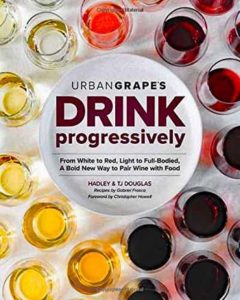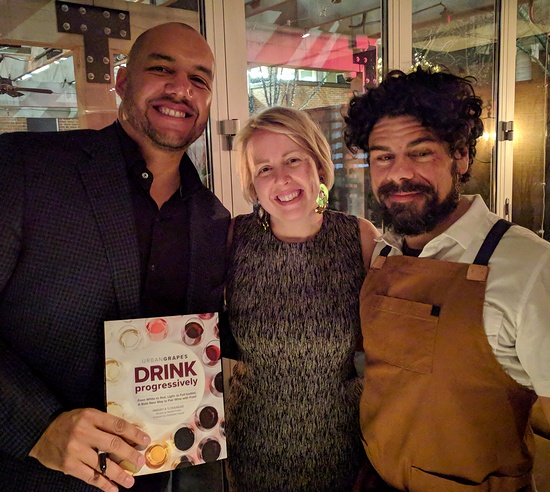One of the pioneers of New American Cuisine, Harvest restaurant (44 Brattle St, Cambridge, Mass., 617-868-2255, harvestcambridge.com) continues its innovative ways with contemporary New England fare from chef Tyler Kinnett. “The Book and the Cook” dinner series highlights recipes from a new cookbook—usually with the author appearing to explain the food and the approach as well as to guide the Harvest staff in the kitchen.
 The series kicked off 2018 with Urban Grape’s Drink Progressively, by Hadley and TJ Douglas with recipes by Gabriel Frasca, the accomplished executive chef of Straight Wharf (straightwharfrestaurant.com) on Nantucket. As you can see from the photo at top, all three showed up for a great dinner and book signing. This was an unusual event in the series, since the book focuses principally on a system for pairing wine with food.
The series kicked off 2018 with Urban Grape’s Drink Progressively, by Hadley and TJ Douglas with recipes by Gabriel Frasca, the accomplished executive chef of Straight Wharf (straightwharfrestaurant.com) on Nantucket. As you can see from the photo at top, all three showed up for a great dinner and book signing. This was an unusual event in the series, since the book focuses principally on a system for pairing wine with food.
In effect, the book is organized along the same lines as Hadley and TJ Douglas’s wine shop in Boston’s South End. Urban Grape (303 Columbus Ave, Boston, 857-250-2509, theurbangrape.com) shelves wines in a 10-point scale from light-bodied to heavy-bodied. The Douglases call the system “progressive shelving,” and the concept is pretty straightfoward. The lightest-bodied wines, Hadley and TJ say, correspond to skim milk. The wines are rated 1W (for lightest whites) and 1R (for lightest reds). They go all the way to a score of 10, which the couples likens to heavy cream. The book characterizes some selected wines in each of the categories and offers lots of fun observations about wine-drinking. Gabriel Frasca’s recipes put the system into practice for pairing wine and food.
Harvest kitchen puts recipes into practice
After sipping a 2016 La Spinetta Vermentino (a 4W, by the way) over hors d’oevres, we sat down to the business of dinner. Our opening dish of pasta with chicken sausage, broccoli rabe, and big shavings of pecorino cheese was paired with a big, buttery Sonoma Coast chardonnay (10W). Far more oaky than we usually like our chard, it was a super match for the spice of the sausage and the bitterness of the rabe.
The second course was slow-roasted salmon over braised cabbage paired with a light (2R) pinot noir from California’s Santa Rita Hills district. Typical of a cool-region California pinot noir, it had a pronounced flavor of the grape combined with light body and just enough acidity to cut through the unctuousness of the salmon.
 For the third course of duck braised in red wine served with green olives, dates, and polenta, the crew chose a powerful, full-bodied Argentine syrah from the Uco Valley. The Douglases rate it a 10R, but despite 14 months in French oak, the tannins are soft and supple. The wine does have the classic Northern Rhone characteristics of saddle leather and dark berries. By pairing the dark meatiness of the duck with the the sharpness of green olives and the silky sweetness of dates, Frasca created a dish that brings out the very best in this syrah.
For the third course of duck braised in red wine served with green olives, dates, and polenta, the crew chose a powerful, full-bodied Argentine syrah from the Uco Valley. The Douglases rate it a 10R, but despite 14 months in French oak, the tannins are soft and supple. The wine does have the classic Northern Rhone characteristics of saddle leather and dark berries. By pairing the dark meatiness of the duck with the the sharpness of green olives and the silky sweetness of dates, Frasca created a dish that brings out the very best in this syrah.
Indeed, the evening proved to be a great proving ground for Drink Progressively (here’s the link to buy it) and the masterful recipe creations of Frasca. With his permission, we’ve reprinted the salmon recipe below. Note that he has a neat trick for oven-poaching the fish that makes the recipe almost foolproof. In the book version, it’s also served with an apple rosemary purée on the side.
SLOW-ROASTED SALMON OVER BACON-BRAISED CABBAGE
 Wild fish is ideal here because farm-raised fish lacks both the fattiness and flavor that are emphasized in this preparation. Just make sure that the fish pieces are of similar thickness. You’ll see that I ask you to cover the baking dish with plastic wrap—this is not a joke. The salmon will not change color very much as it cooks, and it will remain amazingly moist. —GABRIEL
Wild fish is ideal here because farm-raised fish lacks both the fattiness and flavor that are emphasized in this preparation. Just make sure that the fish pieces are of similar thickness. You’ll see that I ask you to cover the baking dish with plastic wrap—this is not a joke. The salmon will not change color very much as it cooks, and it will remain amazingly moist. —GABRIEL
Serves 4
For Salmon
Four 6-ounce pieces of salmon
kosher salt and cracked black pepper
1 tablespoon ground coriander
1 tablespoon fresh thyme leaves
1 shallot, minced
1 tablespoon butter, melted
1 tablespoon extra virgin olive oil
juice of 1 lemon
For Bacon-Braised Cabbage
6 ounces slab bacon, cut into 1/2-inch batons
1 large onion, diced
1 large carrot, peeled, quartered, and cut into 1/4-inch thick pieces
4 cloves garlic, sliced
1 head green cabbage, cored and sliced
kosher salt and cracked black pepper
1 tablespoon red wine vinegar
2 tablespoons parsley leaves, sliced
Directions for Salmon
Preheat oven to 210°F.
Season the salmon with salt and pepper. In a small bowl, combine the coriander, thyme, shallot, butter, and olive oil. Spread the mixture evenly over the pieces of salmon. Place the salmon in a buttered, oven-safe dish. Cover the dish tightly with plastic wrap and place it in the oven. Cook for approximately 25 minutes, or until a fork inserted in the middle comes out warm. Drizzle lemon juice over the top of each fillet. Take care when removing the salmon from the dish as it will be very fragile. Serve over Bacon-Braised Cabbage.
Directions for Cabbage
In a medium saucepot, cook bacon in batches over medium-high heat until crispy. Transfer bacon to a paper towel-lined plate and reserve the fat in the pot. Turn the heat to medium-low and add the onion. Cook until the onion becomes transparent, 2 to 3 minutes. Add the carrots and cook for 3 minutes, then add the garlic, and cook for an additional 2 minutes. Add the cabbage. Season with salt and pepper. Stir for 1 to 2 minutes, until the cabbage has been lightly coated in the fat. Cover and turn the heat down to low and cook 20 to 30 minutes, stirring occasionally, until the cabbage is mostly tender with just a little bite. Check the seasoning, add the vinegar and reserved bacon, and, when ready to serve, fold in the parsley.

